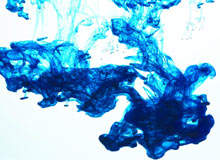
Among a broad spectrum of potential applications, the research that was conducted focused on the molecular mapping of lymphatic endothelial cells and the detection of cancer metastasis in sentinel lymph nodes. As a result, a new agent has been developed that is a more efficient and less toxic alternative to existing nanoparticles and fluorescent labels.
In terms of examining and treating diseased tissue, including cancer cells, it was considered that photoacoustic and photothermal techniques had great potential. The techniques involve applying a laser onto the tissue and using laser-induced sound waves (photoacoustic effects) and laser-induced heat (photothermal effects) for imaging and therapy. Contrast agents, such as nanoparticles, are commonly used to obtain better responses from the tissue.
To achieve non-invasive detection and treatment, the absorption of contrast agents in the near-infrared (NIR) region with maximum light penetration is a very important issue. Because most tissues are relatively transparent to NIR radiation, the targeting of tumour cells with strongly NIR-absorbing nanoparticles can allow both highly sensitive diagnosis and targeted killing of tumours without harming surrounding healthy tissue. Also, the strong absorption of nanoparticles significantly improves the assessment of deeper tissue because it allows deeper laser penetration with minimal attenuation, and increases the detection sensitivity of cancer cells or bacteria labelled by the nanoparticles.
Recently, scientists have found that carbon nanotubes might outperform conventional contrast agents such as coloured dyes. In particular, in a previous study, they demonstrated that carbon nanotubes had great potential as NIR contrast agents for the photoacoustic detection and photothermal killing of individual bacteria in the blood system. However, carbon nanotubes suffer from relatively poor NIR absorption, and questions still abound about their toxicity.
This problem was addressed by depositing a thin layer of gold around the carbon nanotubes. The gold layer enhanced absorption of laser radiation and reduced toxicity. In vitro tests showed only minimal toxicity of the golden carbon nanotubes (GNTs). Furthermore, the synthesis process is a very robust and simple, inexpensive and environmentally friendly one.
The reaction of the carbon nanotubes and gold chloride occurs in water and happens at ambient temperature. No other chemicals or special conditions, such as heating, are required. The chemically inert gold coating does not require toxic precursors and its low laser fluence requirement, due to the enhanced laser absorption, suggests GNTs’ excellent clinical applicability.
How well do you really know your competitors?
Access the most comprehensive Company Profiles on the market, powered by GlobalData. Save hours of research. Gain competitive edge.

Thank you!
Your download email will arrive shortly
Not ready to buy yet? Download a free sample
We are confident about the unique quality of our Company Profiles. However, we want you to make the most beneficial decision for your business, so we offer a free sample that you can download by submitting the below form
By GlobalDataThe new hybrid GNT contrast imaging agent was integrated with an advanced photoacoustic and photothermal technique, which has many advantages in time-response, sensitivity and spatial resolution compared with existing optical modalities. Lead researcher Jin-Woo Kim, whose expertise spans interdisciplinary fields of biomedical engineering, biology, chemistry and nanotechnology, pioneered ‘green’ methodology to produce the novel hybrid golden carbon nanotubes and their medical applications.
Fellow lead researcher Vladimir Zharov, who is one of the pioneers of photoacoustic spectroscopy / microscopy and its medical applications, developed the modified devices with improved time-resolution and multispectral excitation of the ultrasound wave (photoacoustic is a combination of tunable laser and ultrasound technologies). This unique combination enabled the successful demonstration of the unique capability of the GNT-based photoacoustic and photothermal technical platform for cancer research, in particular to detect tumour cells and to map sentinel lymph nodes.
Why GNTs?
The novel hybrid plasmonic contrast agent GNT, which combines the advantages of gold and carbon nanotubes, presents a unique set of features. The size of GNTs can be changed easily by adjusting the length and diameter of the carbon nanotubes and the thickness of the gold layer. This can be done by controlling the growth time of the gold layer and the carbon nanotube treatment procedure and/or by using different types of carbon nanotubes such as double-walled and multiwalled carbon nanotubes.
The hollow cylindrical core, 1nm-2nm, and thin gold layer up to 150-200 atoms only and a total thickness in the range of 2nm-10nm depending on applications, make it an ultra low-weight material. The high surface area on the thin and long GNTs may allow several biomarkers to be conjugated for simultaneous multiplex targeting. By changing the length, diameter, aspect ratio and thickness of the gold layer, the NIR absorption can be adjusted for multicolour detection. Also, the hollow core, which can lower the heat capacity to allow better pulse heating, may potentially carry therapeutic payloads such as drugs, magnetic materials, ethanol and other chemicals.
Owing to their spatial structure, with a hollow empty core as the “long hole” in GNTs, and high absorption cross-section, which exceeds their geometric cross-section by more than one order of magnitude, the results suggest that GNTs, using the analogy of black holes in space, could be called “black nanoholes”, as photons travelling far outside the GNTs can be “trapped” by them. This new nanomaterial could be an effective alternative to existing nanoparticles and fluorescent labels for non-invasive targeted imaging of molecular structures in vivo.
GNTs at optimal configurations can absorb NIR radiation more effectively than the carbon nanotubes although they are shorter than carbon nanotubes used in previous studies. So, simply speaking, higher concentrations of carbon nanotubes will be required to have the same photoacoustic and photothermal responsiveness as GNTs.
Taking into account the issue of toxicity, the amount of nanoparticles applied for biomedical applications such as in vivo clinical diagnosis in humans becomes more important: the less, the better. As long as the controversy exists and until full-scale studies prove one way or the other, one should not assume particles to be safe, as is the case for carbon nanotubes.
In addition, the high NIR absorption of GNTs requires extremely low laser energy levels that might provide non-invasive imaging of single cells in deep tissues and even their targeted ablation when necessary, in particular in the cases of pathological lymphangiogenesis (enhanced lymphatic network) in tumours. Because of their high NIR absorption, only low GNT concentrations are required for effective diagnostic and therapeutic applications. Furthermore, gold is chemically inert, so it is possible to rule out potential toxicity.
Compared with the currently popular gold nanorods, which is similar in shape, the advantages of GNTs include:
- simpler and environmentally friendly synthesis procedures, which do not requires toxic precursors like cetyl trimethylammonium bromide (CTAB) for gold nanorod synthesis
- potentially smaller diameter (up to a few nm vs 12nm-15nm) that may provide more effective penetration through biological barriers such as cell membranes and vessel walls) in whole living organisms
- an empty core that might be filled by any desired material’s therapeutic agents, such as drugs, magnetic materials, ethanol and other chemicals, to further enhance their diagnostic and therapeutic effects.
Although a full evaluation is required, the toxicity test results in vitro as well as in mice demonstrated GNTs’ minimal toxicity. Also, the use of gold in medicine has been documented for more than 50 years, including the clinical testing of colloidal gold nanoparticles to treat rheumatoid arthritis. Recently, gold-based nanoparticles, in particular gold nanoshells (commercial name, AuroLase, Nanospectra Biosciences) and colloidal gold nanospheres conjugated with tumour necrosis factor alpha (Cytimmune Sciences) have been approved for pilot clinical trials for cancer treatments. It is therefore believed that gold coating could potentially improve the biocompatibility of carbon nanotubes and thus make their future clinical applications possible.
Potential applications
The new multifunctional nanoparticles can serve as super-contrast agents for advanced photoacoustic detection and imaging techniques and as thermal sensitisers in photothermal therapy with many potential applications, including early diagnosis and well-timed therapy of cancer, bacterial and viral infections, for example antibiotic-resistant staphylococcus aureus and vascular malformations.
In the study, the molecular detection of lymphatic endothelial cells and the highly precise targeted destruction of lymphatic wall in vivo was demonstrated. This holds promise for the mapping and destruction of intra or/and peri-tumour lymph vessels that provide initial dissemination of detached tumour cells to metastatic sites.
Another example is to apply our developed technique for the detection and purging of cancer metastasis in so-called sentinel lymph nodes. This is important for early cancer staging with the potential to improve cancer treatment and reduce a patient’s morbidity through the replacement of the conventional surgical approach with non-invasive laser ablation.
Next steps
This new nanomaterial could be an effective alternative to existing nanoparticles and fluorescent labels for non-invasive targeted imaging of molecular structures in vivo. The exploration of the optical properties of this nanoparticle with different dimensions is continuing, as is using double and multiwalled carbon nanotubes as core and different bioconjugation for targeting normal and abnormal cells.
The research showed that GNTs can target lymphatic vessels in a well-established live animal model. Although recent discoveries in the biology of lymphatics have emphasised their key roles in human health and immunity, as well as the development of many diseases, lymphatics have received much less attention compared with molecular targeting of blood vessels. To date, many questions on lymphatic functions remain unanswered, including in vivo control of lymphangiogenesis and ways to track and eradicate metastatic cells in prenodal lymphatics and the sentinel lymph nodes.
GNTs may be used for a variety of biomedical applications including non-invasive and highly target-specific lymphatic diagnosis and therapy, as well as treating tumours and infections. Specifically, the potential of GNTs for molecular detection and eradication of metastasis in the sentinel lymph nodes and real-time tracking of GNTs in ear and skin animal vasculatures is currently being investigated, as is a toxicity study of GNTs in vivo.







